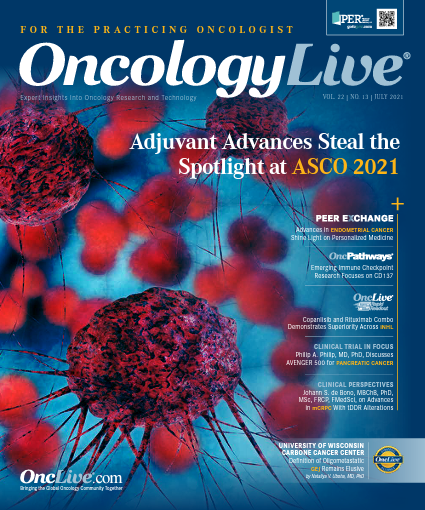Publication
Article
Oncology Live®
MET Inhibition Looks to Advance NSCLC Treatment Landscape
Author(s):
Paul K. Paik, MD, discusses the clinical implications of tepotinib on the non–small cell lung cancer armamentarium.
Paul K. Paik, MD

The presence of MET alterations in patients with non–small cell lung cancer (NSCLC) has been associated with a worse survival outcome, but there are no targeted treatment options available for this subpopulation.
In February, the FDA granted accelerated approval to tepotinib (Tepmetko) for adult patients with metastatic NSCLC harboring MET exon 14 skipping alterations based on data from the phase 2 VISION trial (NCT02864992). Analysis of 2 patients cohorts demonstrated an overall response rate of 43% (95% CI, 32%-56%) with a median duration of response of 10.8 months (95% CI, 6.9-not estimable) among 69 treatment-naïve patients. The response rate among 83 previously treated patients was 43% (95% CI, 33%-55%) with a median duration of response of 11.1 months (95% CI, 9.5-18.5).
In an interview with OncLive®, Paul K. Paik, MD, clinical director of the thoracic oncology service at Memorial Sloan Kettering Cancer Center in New York, New York, discussed the clinical implications of tepotinib on the NSCLC armamentarium.
How do you see the approval of tepotinib affecting the treatment landscape for patients with NSCLC?
The importance of the approval of tepotinib can be thought of in a few different ways. First, of course, it has to do with [a particular subset of patients with NSCLC] who have MET exon 14 skipping alterations. This is a subset that tends to be fairly older; the median age [when these patients receive a diagnosis] is 73 to 74 years across all series. And as way of contrast, the median age for most of our trials in lung cancer is the lower 60s. For some other oncogene- addicted cancers, these are patients who are in their lower 50s; so many of these patients are older. A lot of them are in their 80s, and they have special considerations when it comes to trying to figure out which treatments will be effective but also what treatments will be well tolerated.
These are also patients who generally are not represented in the pivotal upfront trials. There’s been a need for better treatments for these patients. The approval of tepotinib is 1 step forward in that regard, having a fairly well-tolerated oral agent that is effective in this patient population. That’s probably the most important aspect of the recent approval.
Another reason why it’s important is that [MET is] yet another driver alteration that we’ve been able to target in lung cancer. For me, the more [targets] we’re able to find for our patients, the greater the chance is that we’ll be able to offer some other options for these [individuals]. As it relates to biomarker testing in this population, word’s getting out that we should be performing next-generation sequencing as a standard of care for all of our patients at the time of diagnosis. This [approval] helps in [supporting] guideline recommendations for doing this in [patients with] lung adenocarcinoma and squamous cell lung cancer.
What is the incidence rate of patients with NSCLC who harbor MET exon 14 skipping mutations?
The incidence of MET exon 14 skipping alterations in NSCLC for all-comers is approximately 3% to 4%, depending on the series that you end up looking at. It tends to be more common in patients who have lung adenocarcinoma than in patients with squamous lung cancer. Importantly, there’s a rare histologic subtype of NSCLC—these patients have sarcomatoid carcinomas, which are pretty treatment refractory. We find MET exon 14 skipping alterations in approximately [one-fourth to one-third] of these patients. It’s a subpopulation who should definitely be tested for these alterations.
What are some highlights from the VISION trial design and efficacy data?
One of the unique aspects [of the VISION trial] was that ctDNA [circulating tumor DNA] testing was built in. We had serial assessment, a molecular assessment for the determination of resistance and sensitivity. Some of these data were presented in our article in the New England Journal of Medicine and will be presented at other meetings. [These data] have been valuable in terms of trying to map out what the next steps are going to be for the developments of the field.
Oral therapies are important for a few different reasons. One tends to be psychological. [Patients are] trying to regain a sense of independence and freedom after [receiving a] diagnosis of cancer. Oral therapies generally lend themselves to that because you’re not tied to the sort of cancer institute [where you have to go] every couple of weeks or every few weeks. And so there’s a lot more flexibility in terms of assessments and obtaining the drug. [Another reason is] that, by and large, the oral therapies that we’ve developed that are targeted tend to be pretty well tolerated. Again, that has been an important boost in the treatment landscape, particularly for our elderly patients.
What do you foresee for tepotinib in terms of broadening its efficacy?
Things that we’re already beginning to think about include exactly how to increase the efficacy and also potentially manage the adverse effects with MET inhibition.
[This includes] trying to figure out why patients develop resistance to this [agent], and still we’re in the early stages of figuring this out. The data presented [thus far] have shown nicely what some of these resistance profiles are, depending on the kind of MET inhibitor that’s used. We’re beginning to understand that the early data suggests that there’s not going to be kind of a silver bullet for most patients in terms of overcoming resistance.
A lot of the focus now is trying to figure out how we can extend the efficacy of [MET inhibitors] with combination therapies up front. The logical [next step is to] look at [tepotinib] in combination with existing treatments. For example, combination with chemotherapy, [or] combinations with other targeted therapies might be of interest. There’s ongoing development with MET antibodies, which we initially had looked at a decade ago but that failed to generate an efficacy signal in randomized phase 3 data. But we’re beginning to [revisit that] as it relates to targeting MET exon 14 skipping.
Reference
- Tepmetko. Prescribing information. EMD Serono Inc; 2021. Accessed June 18, 2021. https://www.accessdata.fda.gov/drugsatfda_docs/label/2021/214096s000lbl.pdf



























%20(2)%201-Recovered-Recovered-Recovered-Recovered-Recovered-Recovered-Recovered-Recovered-Recovered-Recovered-Recovered-Recovered-Recovered-Recovered-Recovered-Recovered-Recovered.jpg?fit=crop&auto=format)
%20(2)%201-Recovered-Recovered-Recovered-Recovered-Recovered-Recovered-Recovered-Recovered-Recovered-Recovered-Recovered-Recovered-Recovered-Recovered-Recovered-Recovered-Recovered.jpg?fit=crop&auto=format)
